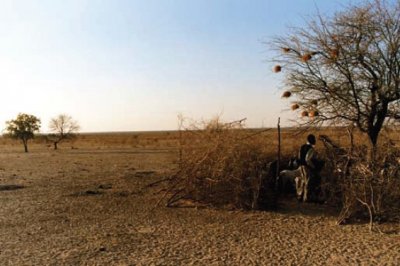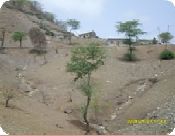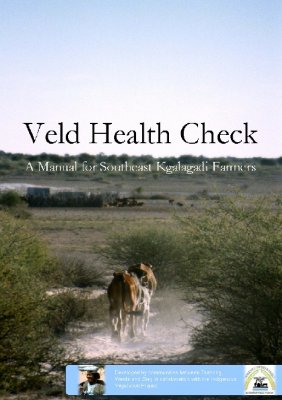|
Reed, MS et al. 2008. Veld Health Check: a Manual for Kalahari Farmers. Leeds University Press, UK
Abstract
| Anyone who has walked any distance in the Kalahari bush, knows the importance of knowing precisely where you are going, and how you’re going to get there. They also know the value of recognising nature’s signposts to make sure they’re going the right way: clues from the sun and stars, or which side of a tree the weaver bird builds its nest. |
 |
Similarly, it is not easy for a farmer to embark on a journey towards good rangeland management without knowing precisely where he or she is going, or how to get there. With no knowledge of nature’s warning signs, they don’t realise they are lost until it is too late, and will have problems finding their way back to the path.
The purpose of these manuals is to provide Kalahari farmers in three regions of Botswana (mid-Boteti, southwest and southeast Kgalagadi District) with a range of different routes (management options) to reach their destination (sustainable rangeland management). They are designed to help farmers read nature’s warning signs, so they can tell if their management is leading them towards better or worse rangeland. With this knowledge, a farmer can soon tell if their management is working, and if not, make changes to get back on course. Any farmer with experience of the rangeland has some knowledge of these signs. However this knowledge is rarely voiced or shared with others. These manuals therefore share the knowledge of Kalahari farmers about warning signs and management solutions to common rangeland problems. This knowledge has been combined with the knowledge of researchers from around the world, and carefully evaluated by community groups from each of the three regions, in addition to researchers and extension workers.
 |
The manuals are designed to help farmers improve the quality of their rangeland by recognising and responding to rangeland damage caused by livestock. Although some of the worst damage happens during drought, the manuals are not designed to help farmers predict when a drought will happen. However, they can help farmers work out if lasting damage has been caused by livestock during a drought (or at any other time) and choose the best way to respond. |
The purpose of the manuals is therefore to enable farmers to:
| 1. |
a) Recognise warning signs that the condition of the rangeland is likely to become worse in the future |
|
b) Change rangeland management to prevent this from happening |
| 2. |
a) Recognise areas of the rangeland that are already badly damaged |
|
b) Focus efforts on these areas to restore them to better condition |
Many books and manuals have been developed for ranchers, but there has been little help for farmers who use unfenced, communal land. These manuals are therefore primarily designed for use by communal farmers, although they will still be useful for ranchers (particularly for monitoring). The warning signs and management options have been specially selected so that they can be used easily by anyone with no need for specialist training or equipment.
Download the full manuals
© Indigenous Vegetation Project and University of Leeds, 2008. Published by University of Leeds Press, UK. All rights reserved. No part of these books may be reproduced by any means, or transmitted without the written permission of the lead author.
|








